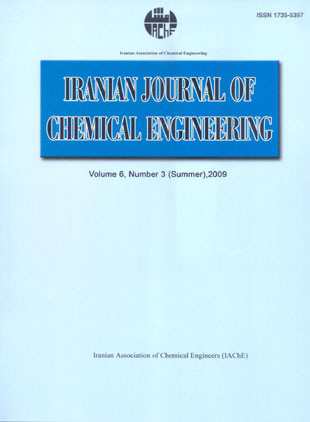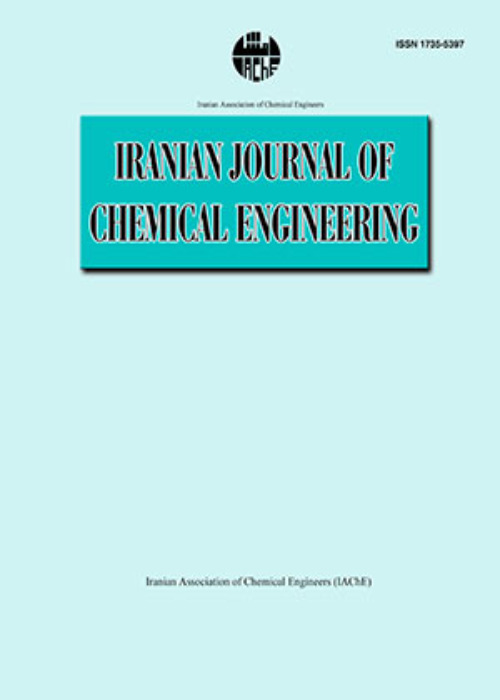فهرست مطالب

Iranian journal of chemical engineering
Volume:6 Issue: 3, Summer 2009
- تاریخ انتشار: 1388/06/20
- تعداد عناوین: 8
-
-
Page 3
The effect of jet positions on the homogenization progress of a dye in a rectangular tank equipped with a jet was studied. Water entered the tank laterally from the top and left the tank from the opposite wall at the same height. The suction position was fixed at one of the tank corners and seven positions were considered for the jet nozzle. A predefined volume of the dark Nigrosine was injected to the tank input as the tracer during 4s in all experiments. During the dye injection and mixing progress, the front and bottom views of the tank were recorded by a digital camera. The experimental results showed that as the jet nozzle was installed in the opposite wall from the tank input, the worst performance was obtained in comparison with the other jet positions. However, the jet nozzle position of 90 with respect to the tank input had the best performance. All of the experiments were modeled by Computational Fluid Dynamics (CFD). Finally, the CFD predicted dye spreading was verified by the experimental observations and a good agreement was observed between the CFD and experimental results.
Keywords: Jet, Homogenization, Mixing, CFD, Modeling -
Page 13Waste heat recovery is very important, because it not only reduces the expenditure of heat generation, but also it is of high priority in environmental consideration, such as reduction in greenhouse gases. One of the devices used in waste heat recovery is heat pipe heat exchanger. An experimental and theoretical research is carried out to investigate heat performance of an air to water thermosyphon heat pipe heat exchanger according to ε-NTU method. The experiments were done according to the following procedure: cold water with 0.1kg/s flows through the condensation section and hot air in a closed cycle is blown into the evaporation section. A blower with varying frequency of current turns in the mass flow rate between 0.14-0.6 kg/s and a temperature range of 125-225C. The results of the experiments show that as the ratio of rises, the rate of heat transfer goes up. The efficiency of the heat pipe heat exchanger remains constant as the temperature of the hot stream goes up, but the amount of heat transferred increases.Keywords: Thermosyphon heat pipe heat exchanger, ε, NTU method, In, line configuration
-
Page 26Dispersion of heavy gases is considered to be more hazardous than the passive ones because it takes place more slowly. When the gas is accidentally released at ground level or where there are many obstacles in the area it is considered to be a heavy gas. In this paper, based on the extensive experimental work of McQuid and Hanna, the model was tested against two types of experiments: A simple experiment “Thorney Island” and a complex experiment “Kit Fox” in order to validate CFD code. In order to accomplish this validation the multiphase approach was employed. Also, the vertical temperature gradient in the atmosphere was investigated. The investigation of wind speed was done taking factors such as time, height and direction into consideration. In order to reduce the number of elements in the computational domain, a combination of 2D and 3D geometry was utilized. The results showed that the wind inlet correction, as well as the temperature gradient, had a significant influence on gas concentration records.Keywords: Heavy gas dispersion, Temperature gradient, Complex train, CFD
-
Page 46Experimental measurements of overall gas holdup (εg), residence time distribution (RTD) and liquid mixing time (tm) have been carried out in an air-water system in a 17 lit bubble column with an 11 cm diameter, over a wide range of superficial gas velocity (0.14-1.46 ms-1) and height to diameter ratio (1.36-8.84). The bed expansion method was used to obtain holdup values and the change of slope related to εg versus superficial gas velocity (Usg) indicated the transition point from homogeneous to heterogeneous regime at Usg= 0.7-0.9 ms-1. Besides, the experiments illustrated that H/D ratio had no effect on holdup values. The axial dispersion model was used with semi-closed boundary conditions for prediction of RTD, and hence, the axial dispersion coefficients (Dax). Moreover, fitting results of the model and experimental RTD curves achieved from tracer injection method attained the model parameter, Dax , in three H/D ratios of 4.73, 6.36 and 8.84. Results showed that an elevation in H/D ratio, caused a rise in Dax. On the other hand, the mixing time data declined with an increase in Usg; however enhancement of H/D ratio caused an increase in tm.Keywords: Bubble column, Overall gas holdup, Residence time distribution, Axial dispersion coefficient, Mixing time
-
Page 57In this paper, the experimental data of the onion drying process by a batch cabinet dryer is investigated. Obtained experimental data including moisture content, shrinkage, and rehydration via random factorial scheme are analyzed. Comparison of data average is carried out with the help of the multi amplitude test of Duncan. Statistical analysis of experimental data shows that time, temperature, and their combined effect have a reasonable impact on the moisture content and rehydration value of dried samples. However, a combined effect of time and temperature on the shrinkage value is not meaningful (P>0.05). The results also show that increasing time and temperature leads to a decrease in the moisture content of the samples, but it increases the value of rehydration and the shrinkage of samples.Keywords: Drying, Onion, Moisture content, Rehydration, Shrinkage
-
Page 71In this study, we examined a scale-up to production of nickel perovskite catalyst, used in the conversion of natural gas to synthesis gas, using the sol-gel method in the laboratory and a bench-scale reactor. The required volume of solvent and catalyst activity in the methane-reforming reaction was determined from the optimum catalyst production conditions at the laboratory scale. This information was then used to design the bench-scale unit. We used heat-transfer models in a non-continuous bench reactor and scale-up fundamentals to achieve the same physical and chemical properties of the catalyst as that in the laboratory sample. A correlation coefficient corresponding to the experiment conditions, including the stirrer geometry, is presented based on the heat transfer equations in stirred tanks. This correlation can be used to estimate the heat-transfer coefficient at larger scales, such as in a pilot reactor.Keywords: Scale-up, Perovskite, Reforming, Sol-Gel
-
Page 88Electro-Hydrodynamics (EHD) spray is an important process in many engineering operations such as ink-jet printing, spray drying and atomization (liquid jet in air), dispersion and emulsification (liquid jet in liquid). In this work the method of electro-spray was employed to form droplets from a high viscous sodium-alginate solution using constant DC voltage. The droplets were cured in calcium chloride solution to produce solid beads. The main objective was to extend the knowledge of EHD spray to high viscous and non-Newtonian liquids (1000-5000 mPa.s). However, the effects of electric field strength, nozzle diameter, flow rate and concentration of liquid were specifically investigated on the size of the beads. Among the parameters studied, voltage had a pronounced effect on the size of the beads as compared to the flow rate, the nozzle diameter and the concentration of alginate liquid. The size of beads was reduced to a minimum value by increasing the voltage in the range of 0-10 kV. However, within the middle part of this range, an unstable transition occurred from the dripping mode to the jet mode where the size distribution was wide. Increasing the height of fall of the droplets improved the sphericity of the beads, because of the increase of flight time for the droplets to relax before gelation.Keywords: Electro-spray, Non-Newtonian and viscid liquids, Constant DC voltage, Alginate beads, Size distribution
-
Page 99


